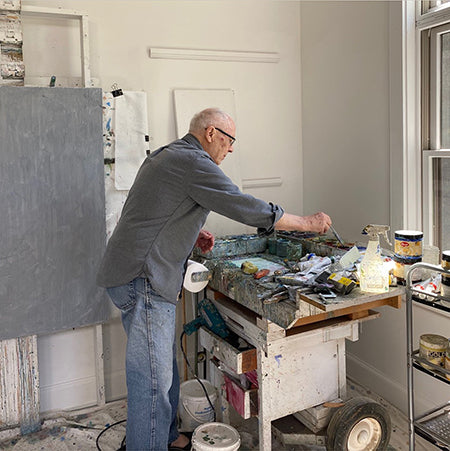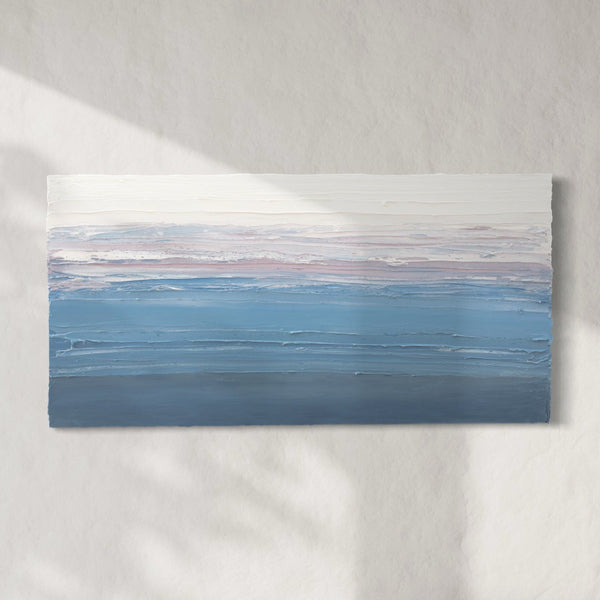Elwood Howell is an American abstract painter who lives and works in New York. His paintings, which drastically range in size, follow a consistent composition centered around a textured, layered canvas and a high horizon line. He uses small, often organic but always colorful shapes to form landscapes that, while imaginary, are bucolic, peaceful, and balanced. We spoke with Elwood about his many years as a practicing artist and how he achieves his signature textured compositions. Read on to learn more about Elwood and see inside his Hamptons-based studio. You can also learn about his solo exhibition, Rooted in Color, or see all of his artwork on his Artist Page.
Our Interview with Elwood Howell
Where are you from originally and where are you located now?
Life? It began in the small Illinois prairie town of Delavan in 1933. From there we moved to the family farm outside of Woodstock, Illinois after my grandparents' retirement. I started my art career in Chicago. Then Nancy and I moved our small family to East Hampton, NY in 1974 where we still reside.
How would you describe your artwork?
My paintings are of an abstract nature with a sense of place, created in the studio.

Walk us through your creative process...
It is definitely a process. I start by creating a textured surface using gesso, modeling paste, pumice gel, and as of the last few years, an ordinary scrub brush to add a faux, linen-like surface on canvas or wood panel. Over that surface I add more of the same gesso, modeling paste, and pumice using a palette knife, painting brushes, and other tools. Then I sand down the entire surface with a heavy-duty circular sander leaving a slight image of the texture. Next, with the application of color I usually mark off the three areas consisting of the larger more abstract lower mass, topped by the mood-inducing "sky" area. The "subject" middle area starts to take form from there. During the painting process, if need be, I may repeat the same aforementioned texturing process again, days or even weeks later by reworking the surface in small areas of the canvas. I go back and forth as the painting begins to "speak" to me by silently asking for clarification through new colors and shapes. Often I set a canvas aside to rest and work on other paintings that may be moving along in the same type of progression. Restarting a painting later with a fresh vision, free from previous thinking is just that - freeing. It still is a back-and-forth process, but always moving forward.
What's your favorite part of your process?
My favorite part is the realization that the painting is about to come together and be finished. However, sometimes, even years later, small changes sometimes will still need to be made.
Is there ever a particularly challenging part of the process?
Challenges are always present. But setting the work aside is always a big help.
Where do you find inspiration? Are there any particular artists who have inspired your work?
There are too many to mention. I've even taken small helpful hints from artwork by little-known artists.

All of your paintings include a more-or-less defined, but always relatively high horizon line. What drew you to the horizon, and does it have any particular meaning in the context of your work?
After my first horizon painting, I became intrigued by the workable lower space and titled all of those, at the time, "Prairie Paintings" since much of Illinois was prairie. As for applying the word 'meaning' to my paintings, I will let others come up with whatever suits them. All I am doing is presenting a visual message just as much music is pure sound. I am not a message artist.
You tend to use really unique colors. How do you select the palette for each piece?
The choice in color palette happens at the beginning of a work, but it's rather random, and then rapidly changes after a second color is applied. From then on, it is the painting that dictates color and shape. I am more like a tool that executes the particular painting's needs. But then, I take charge and have to dictate when the work is completed.
From your first painting to those you create now, has your work overall changed?
The first painting? You mean, like in second grade? It is and always has been an ongoing process. However, the changing has slowed down considerably over the years as I mellow out.
Did the pandemic affect your creative process at all?
None, none-what-so-ever.
If you could give one piece of advice to your younger self as an artist, what would it be?
Advice? Be more sociable.

In 5 words or less, what is your goal as an artist?
Continue working and enjoy family.
Now for something different: coffee or tea?
Neither, I'll take water.
Are you a morning person or night person?
Both, nap time is at 2:00pm.
Books or movies?
If a book has plenty of pictures, but if not, I go with the movie.
Warm weather or cold weather?
Prefer warm or cold weather? Both, I'm a man of all seasons.
Lakes or oceans?
Both, each has its positives.
What do you do in your free time (aside from art/photography)?
Climb mountains, run marathons, and sky dive. Just kidding. The answer is a simple one: Enjoy life.
Elwood Howell's artwork is on view at Sorelle until July 1 in a solo exhibition, Rooted in Color. To shop all of Elwood's art, including original paintings as well as limited and open edition prints, visit his Artist Page, or contact us for more information.



0 comments
Post a comment